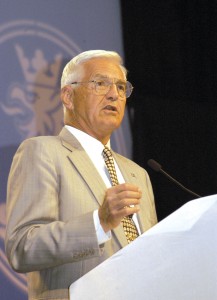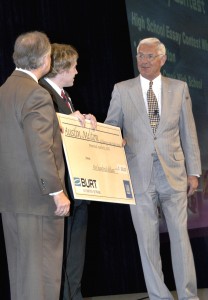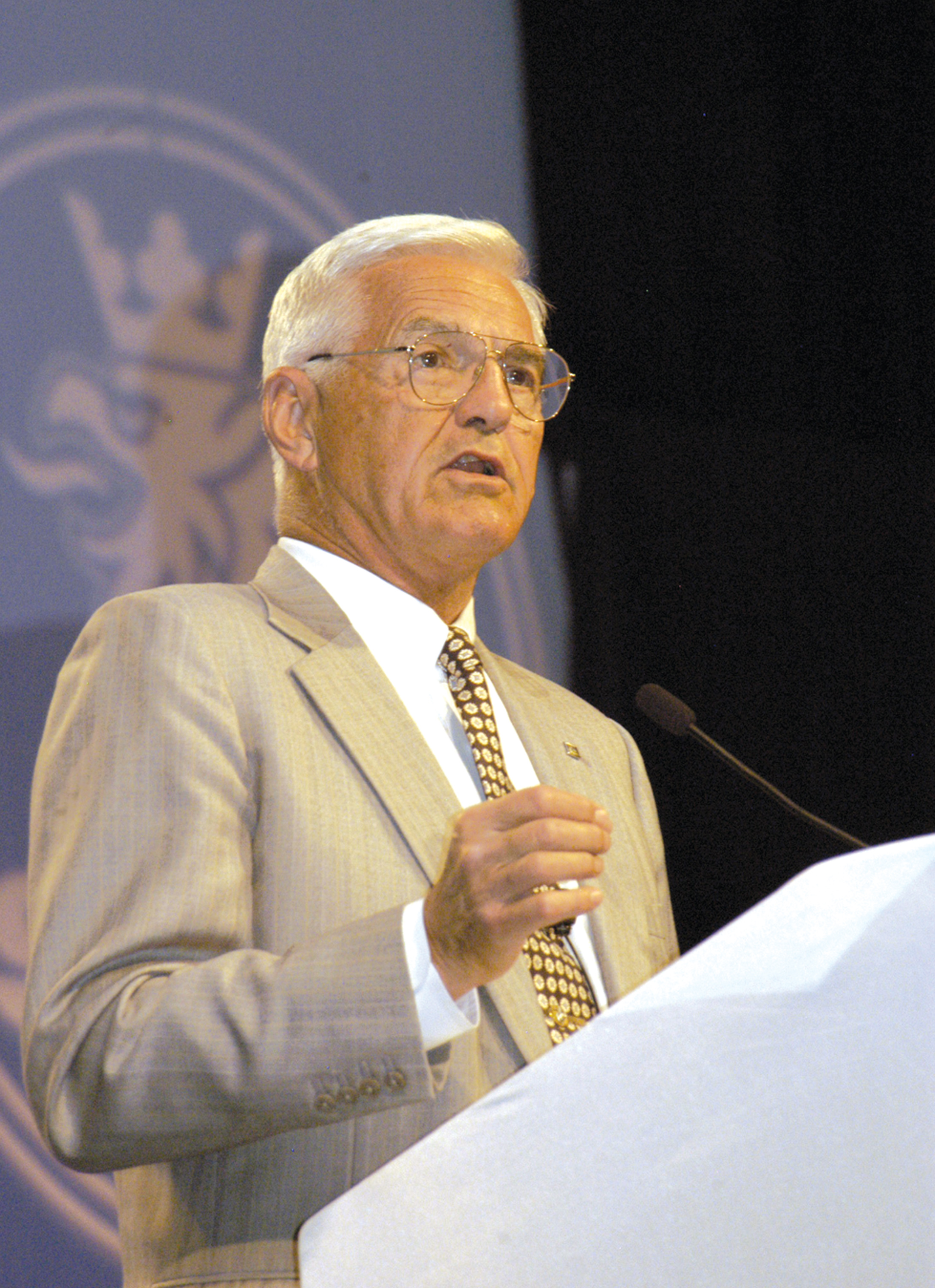By Deb Smith

Robert Lutz held attendees spellbound at AutoVenture 2005, where he discussed the state of GM and new and exciting products.
Robert A. Lutz, General Motors’ silver-haired vice chairman of global product development, made a recent trip to Denver. Lutz, known for his frank, charismatic leadership style and industry expertise, was the keynote speaker of AutoVenture 2005, a special luncheon attended by over 1,000 at the Colorado Convention on March 31. The South Metro Denver Chamber of Commerce and the Metro Denver Automobile Dealers Association organized the luncheon, held in conjunction with the Denver Auto Show.
At the time of his address, during which he talked about the state of GM and some of its exciting new products, Lutz held the additional role of chairman of GM North America. One comment he made was that in the past, it’s often been overlooked that although GM was the world’s largest automobile company in name, if you took the lid off and looked inside, it was really four small automobile companies—one in Latin America, one in Europe, one in Asia Pacific and one in the U.S.
“GM was more like a holding company that owned four smaller automobile companies,” he said. “That’s not the way to compete against Toyota and Nissan and Honda, who are large monolithic companies operating globally with one world-wired engineering pool, one worldwide design group, and so forth. So we made the transition to being global.”
Lutz said GM has now globalized engineering, design, procurement, information systems and manufacturing, with global operating and capital budgets. Since his address, GM Chairman Richard Wagoner has announced further changes at the world’s largest automaker, which will help the company move closer to operating as a truly global auto company, instead of four quasi-independent regional ones.
The organizational changes followed Lutz’s suggestion that he relinquish his title of chairman of GM North America. He believed that was necessary so that he could concentrate entirely on the development of the company’s new cars and trucks for all its global markets.
“I just couldn’t do that job the way it should be done while also having responsibility for GMNA,” Lutz said. “Rick is taking over GM’s North American operations himself. I will focus 100 percent of my time on my role as the head of global product development. Gary Cowger will focus 100 percent of his time on his role as the head of global manufacturing and labor relations.”
Lutz said the organizational changes will mean that he can now direct his full energies to the areas where he can make the biggest difference.
GM redefining brands
Lutz, the only person to have been at the head of all three major automotive companies in the U.S., captivated the sell-out crowd. The 73-year old automaker, recently under fire amid drastically slashed earning reports for 2005 and “rumors” of plans to eliminate both Pontiac and Buick, opened his remarks with a very firm message defending GM’s loyalty to its entire product line.
“We are fervently supporting ‘all’ of our brands,” he said. “We have very robust future product plans for all of them and we continue to have rock-solid faith in all of them.”
He said that GM is working to redefine its various brands, and has rededicated itself to building great cars and trucks—even “better than they have to be.” He addressed a statement taken out of context that he made to an analyst earlier in March.

Robert A. Lutz, vice chairman of global product development, General Motors, was the keynote speaker of AutoVenture 2005.
“If all you know about GM is what you read in the newspaper and see on TV, then you probably think I’ll personally be turning the lights out and padlocking the doors to GM’s headquarters for good,” joked Lutz. “What I said was that if the brand-—in fact, any brand-—consistently underperforms for many years, and couldn’t turn itself around despite all the money we might spend on it, we could find ourselves in a position where we might have to look at the phase-out of that particular brand.”
Lutz said his comments were simply “a straightforward answer to a hypothetical question.”
“In clear ‘non-hypothetical’ terms, we are not discussing the elimination of any GM brand,” he said. “We are investing more than ever in product and marketing programs to build all of our brands. We love all our children equally and nobody gets pushed out of the house.”
Lutz said the company has been experiencing excellent sustained sales and performance, driven by new products and goals.
“GM sales in March improved significantly versus our results from the first two months of this year,” he said. “In fact, our retail sales-—that’s the kind we like-—should be up nearly 30 percent.”
Lutz said GM plans to regain market share and boost sales with an exciting new lineup of cars and trucks for 2006.
“We’re in the process of rolling out an almost unprecedented wave of new cars,” Lutz said.
He said GM is very encouraged by the continued sales trends with the new Pontiac G6, the Buick Lacrosse and the Chevrolet Cobalt.
“All three are well on the way to having their best ever sales results,” he said.
Lutz pointed out that the initial G6 model will soon be joined by others, including an all-wheel coupe and America’s first retractable hardtop, four-passenger convertible. Among the other cars he spoke enthusiastically about were the Pontiac GTO and the “stupendously fast” Cadillac XLR-V, sporting 440 horsepower, which was first shown in March at the New York auto show, and will go on sale later this year.
“Cadillac is well on it way into a great turnaround,” Lutz said. “Sales are consistently up over last year.”
Lutz said the two brands GM is going to be spending a lot of money and effort on are Buick and Pontiac, because they’ve been neglected for so many years.
“Both those brands are getting many new products,” he said.
He said Pontiac by far now has the best product lineup of its history, and that GM has about three billion dollars in investment behind the revitalization of Buick.
The Buick Lucerne, a full-size sedan with an optional V-8 (the first time in a Buick sedan since 1995), is the most dramatically-styled Buick in decades.
“The object here is to obtain a level of luxury and artisanship similar to the best German and Japanese luxury cars, but at the price at where you would expect a Buick to be priced,” he said.
Pontiac will also introduce its first crossover sport utility vehicle this year. Lutz said the V6-powered Pontiac Torrent, a medium- to low-price SUV, will share many traits with the very successful Chevy Equinox.
“It will have a lot of unique Pontiac visual treatments as well, including a very nice up-market interior,” he said.

L.G. Chavez Jr., president, Burt Automotive Network, and Robert Lutz, vice chair of global product development, General Motors, present high school student Austin Melton with a scholarship for his winning essay.
The Pontiac Solstice, a classy little convertible roadster, remains practically unchanged from its concept design.
“It will be available for the list price of $19,995,” said Lutz. “We are keeping our promise of doing a sports roadster for less than $20,000.”
Lutz said Saturn was also previously neglected, but that has changed.
“We left them with only one car for too long,” he said. “Saturn is going to have a great product lineup, which will be a little more import-oriented.”
That transformation begins with the Saturn Sky, another roadster to be introduced for 2006.
“Initially it will have a four-cylinder engine with 170 horsepower, and it will be priced to give the Mazda Miata a real run for the money,” said Lutz. “Again, we’re going all out on interiors, because we know interiors for many years were weak on GM products. A lot of people have said to me, ‘Your cars look OK until I open the door and then I don’t like them anymore.’ So we decided to fix that and we’re somewhat overcompensating on interiors.”
Lutz said everyone likes the Hummer, but not everyone likes 11 miles per gallon. GM has come up with a solution.
“The Hummer H3, the big Hummer’s smaller brother, is only weeks away from production and delivery to Hummer dealers,” Lutz said.
Powered by a five-cylinder engine, the H3 is projected to get up to 20 miles per gallon.
Other GM innovations in its 2006 lineup include StabiliTrak, an electronic stability control system that will be standard equipment on GM vans and SUVs by 2007, and across the entire vehicle lineup by 2010. Also, GM plans to make OnStar, the popular in-vehicle safety and security system, standard by 2007.
While GM has an exciting new product lineup across the board, Lutz acknowledged that the company’s been going through a difficult period.
“Overall, we have acknowledged that 2005 is going to be a tough year for us, too, rifled with challenges,” he said. “But that doesn’t mean that I’m filled with gloom and doom. On the contrary, I have seen what this company is up to-—especially in terms of product development, and my hopes are high. So is my confidence in our ability to get the job done. My unshakable confidence in GM is not simply because of the promise of what is to come, but also because of what’s already been delivered.”
One of the problematic issues the company will continue to face is the cost of its rising healthcare plan.
“There are a lot of things that we can control as an American manufacturer,” Lutz said. “For one, we can control quality. There is no excuse for not having the same quality as the imports. … But we cannot influence the escalating cost of the American healthcare system. That’s one of the reasons we’re struggling. In 2005, health care liability for our active employees and retirees is somewhere close to $6 billion.”
Lutz said that while our health care system in America is the most expensive, it’s not necessarily the greatest, and he called the economic burden on the company “atrocious.” He said the expanding cost of healthcare makes it very difficult for a company like GM to stay profitable, and is indicative as to why foreign manufacturers seem more appealing.
He said things have become very difficult for all American automotive manufacturers.
“But we’re big boys and we’re playing in the international arena,” he said. “The whole issue of designing and building cars in the U.S. is difficult. Many of the challenges are our responsibility, and we can certainly step up to those, but to pay close to $1,500 per car in health-care liability when our Japanese competition does not bear that burden—that’s a tough point to offset with productivity.”

Bob Lutz takes time from a busy schedule to autograph his book for Mike Shaw of Mike Shaw Automotive.
Following his address, Lutz and L.G. Chavez Jr., president and CEO of the Burt Automotive Network, presented a $500 scholarship to the winner of an essay contest, in which the participants were metro area high school students. The winner was Austin Melton of Cherry Creek High School.
“I’m encouraged that so many young people took interest in writing an essay that begins with, “If I were the head of an auto manufacturer, I would…” Lutz said. “Because frankly, given the headlines that we’ve seen about GM in the last couple of weeks, I’m surprised that anyone would be interested in running an auto company—especially our nation’s impressionable youth!”
Why AutoVenture?
John Brackney, president of the South Metro Denver Chamber of Commerce, expressed the chamber’s excitement and gratitude at landing Lutz as the keynote speaker of AutoVenture 2005.
“Clearly, this was a major event for Denver,” he said.
Brackney said that most people don’t understand the importance that automobiles have to the economy. In Colorado alone, the automotive industry accounts for nearly $11.2 billion in annual sales of new cars.
“This is a step by our chamber to emphasize the importance of automobiles for our society,” Brackney said. “Often, they’re looked at negatively—noise outside people’s homes, traffic problems, or car accidents. Sure, there are some downsides to automobiles. But, the upsides outweigh the downsides. Automobiles are a huge benefit—economically, to our government, to our freedom.”
Brackney said the chamber thought it was a nice mix to bring out somebody who’s not only a world-renown business executive, but also has an interest in aviation. The former county commissioner recently served as the chair of the Arapahoe County Public Airport Authority, the governing entity at Centennial Airport. Prior to Brackney’s appointment as president, the chamber worked on getting special legislation through Congress for the airport.
Brackney personally was excited about Lutz’s participation for another reason, which was an affinity with the former Marine captain.
“I had 12 years in the military, so there was a personal interest,” he said.
Like many people in attendance at AutoVenture 2005, Brackney is also a fan of Lutz the author. Lutz’s business management book, “Guts: 8 Laws of Business from One of the Most Innovative Business Leaders in Our Time,” takes a prominent place on Brackney’s bookshelf.
“He’s edgy,” he said. “Not only the names of the chapters, which he intentionally tried to make provocative, but he’s also a straight shooter.”
Brackney said “Guts” is a must-read for Lutz’s insightful and practical business principles.
“Clearly, a leader has to have courage, and he’s willing to take very courageous stands and demonstrates examples of that in his book,” he said.
Brackney credits Chavez, a chamber board member, for working diligently to bring Lutz to Denver for AutoVenture 2005. Chavez said the chamber was pleased to be able to give the business community an opportunity to hear from “one of the most dynamic speakers in the automotive industry.”
“Mr. Lutz is a straightforward speaker and has seen the automotive industry through many business cycles and changes over the last 30 or so years,” he said.
Bill Barrow, executive vice president of MDADA, said this is the first time the association has partnered with a local chamber of commerce, and referred to the organization, which boasts over 1,600 members, as “progressive and energetic.”
Brackney said the event was organized as part of the chamber’s efforts to provide educational and high-impact programs to business leaders throughout Denver. The South Metro Denver Chamber of Commerce (www.bestchamber.com) provides four primary programmatic areas including a vigorous Economic Development Group, Small Business Development Center, Public Policy Initiative Counsel and an Event & Visitors Bureau. This is in addition to the more than 70 other various programs and services provided.
“We have made a commitment and this is just a part of the latest business program offerings for both small and large business leaders in our community,” Brackney said of AutoVenture 2005.
Presenting sponsors included General Motors, Burt Automotive Network, Metro Denver Automotive Dealers Association, Vectra Bank, Car Toys, Gates Corporation and Centrix Financial. Supporting sponsors included Guaranty Bank and Trust, Merrill Lynch, Enterprise Rent-a-Car and Allstate Insurance.
AutoVenture 2005 was the second annual AutoVenture.
“We’re looking forward to next year’s,” said Brackney enthusiastically.
SEE THE STORY “BOB LUTZ: GUTS IN THE SKY AS WELL”











